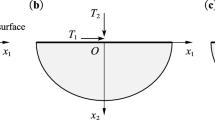Abstract
We study the contribution of surface elasticity to the two-dimensional contact problem in a generally anisotropic material using the Stroh sextic formalism. Surface elasticity is incorporated into the model of deformation using an anisotropic version of the continuum-based surface/interface model of Gurtin and Murdoch. Full-field analytic solutions are obtained in terms of exponential integrals for an anisotropic half-space when the contact surface is subjected to two particular types of loading: first, we consider the case of a uniform load (shearing and pressure) applied to an infinitely long strip of the contact surface and second, by reducing the strip to zero width, we deduce the corresponding result for a concentrated line force acting on the contact surface. The analysis indicates that the surface deformation gradient is finite in the first case of uniform loading of the strip and exhibits a weak logarithmic singularity at the location of the applied concentrated line force in the second case.

Similar content being viewed by others
References
Johnson KL (1985) Contact mechanics. Cambridge University Press, London
Wang GF, Feng XQ (2007) Effects of surface stresses on contact problems at nanoscale. J Appl Phys 101:013510
Long JM, Wang GF, Feng XQ, Yu SW (2012) Two-dimensional Hertzian contact problem with surface tension. Int J Solids Struct 49:1588–1594
Ou ZY, Pang SD (2013) Fundamental solutions to Hertzian contact problems at nanoscale. Acta Mech 224:109–121
Zhou S, Gao XL (2013) Solutions of half-space and half-plane contact problems based on surface elasticity. Z Angew Math Phys 64:145–166
Gao X, Hao F, Fang D, Huang Z (2013) Boussinesq problem with the surface effect and its application to contact mechanics at the nanoscale. Int J Solids Struct 50:2620–2630
Gao X, Hao F, Huang Z, Fang D (2014) Mechanics of adhesive contact at the nanoscale: the effect of surface stress. Int J Solids Struct 51:566–574
Gurtin ME, Murdoch A (1975) A continuum theory of elastic material surfaces. Arch Ration Mech Anal 57:291–323
Gurtin ME, Murdoch AI (1978) Surface stress in solids. Int J Solids Struct 14:431–440
Gurtin ME, Weissmuller J, Larche F (1998) A general theory of curved deformable interface in solids at equilibrium. Philos Mag A 78:1093–1109
Ru CQ (2010) Simple geometrical explanation of Gurtin–Murdoch model of surface elasticity with clarification of its related versions. Sci China 53:536–544
Ting TCT (1996) Anisotropic elasticity—theory and applications. Oxford University Press, New York
Abramovitz M, Stegun IA (eds) (1972) Handbook of mathematical functions with formulas, graphs, and mathematical tables. Dover, New York
Suo ZG (1990) Singularities, interfaces and cracks in dissimilar anisotropic media. Proc R Soc Lond A 427:331–358
Clements DL (1973) A crack between dissimilar anisotropic media. Int J Eng Sci 9:257–265
Acknowledgments
The authors are grateful to two reviewers whose comments and suggestions have greatly improved the presentation of the work. This work is supported by the National Natural Science Foundation of China (Grant No: 11272121) and through a Discovery Grant from the Natural Sciences and Engineering Research Council of Canada (No. RGPIN 155112).
Author information
Authors and Affiliations
Corresponding author
Appendix
Appendix
From Eq. (18) we find that
where
Once \(\mathbf{u}_{,1} \) and \({{\varvec{\upsigma }}}_{2} \) on \(x_{2} =0\) are known, \(\mathbf{u}_{,2} \) and \({{\varvec{\upsigma }}}_{1} \) on \(x_{2} =0\) can be further obtained from the following relations [12]:
It is observed from Eq. (24) that \(\mathbf{{h}'}(z)\) also does not contain the Stroh eigenvalues and eigenvectors. Thus, \({{\varvec{\upsigma }}}_{2}^+ \) in Eq. (60) and consequently \({{\varvec{\upsigma }}}_{1} \) in Eq. (62) are also valid for mathematically degenerate materials.
Rights and permissions
About this article
Cite this article
Wang, X., Schiavone, P. The effects of anisotropic surface elasticity on the contact problem in an anisotropic material. J Eng Math 101, 141–151 (2016). https://doi.org/10.1007/s10665-016-9851-0
Received:
Accepted:
Published:
Issue Date:
DOI: https://doi.org/10.1007/s10665-016-9851-0




